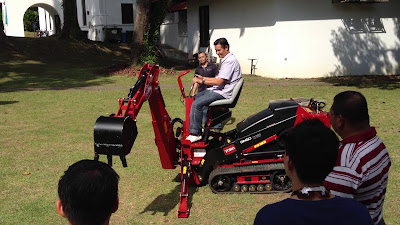I think it was about 5 years ago that CUGE started a programme to rent machinery out to landscape companies in order to encourage them to use more machines or even purchase some of their own after trying the rentals out. Amongst the mechanical wonders were a backhoe, skid-steer + trench digger combo, wood chipper, and get this - a soil potting machine. I don't think the rental programme lasted for 2 years.
A backhoe that has to be repositioned after digging was done at one spot.
A skid-steer that required the operator to stand. More suitable to dig trenches (on flat ground), as the brand name suggested.
This photo was taken from an area accessible to the public after the rental programme had closed. A soil potting machine out in the open with a tarp draped over it, which was breaking down due to being exposed to the elements.
Slightly more than a year ago, NParks released S$3 million for the Landscape Productivity Grant (LPG) to contribute towards the purchase of machinery by landscape companies and plant nurseries. The grant subsidised half of the machine price, and the Productivity and Innovation Credit (PIC) scheme subsidised 60% of the other half. The company would pay for the remaining, which is 20% of the machine price. NParks reported that a previous tranche of the LPG saw companies achieving the following improvements to their productivity through mechanisation.
- 77% savings in man-hours as a result of using wood chippers
- 60% savings in man-hours after switching to the use of ride-on mowers
- 50% savings in man-hours using tractor-mounted hedge-trimmers
- 80% savings in man-hours as a result of deploying a wireless remote mower
- 77% savings in man-hours as a result of using wood chippers
- 60% savings in man-hours after switching to the use of ride-on mowers
- 50% savings in man-hours using tractor-mounted hedge-trimmers
- 80% savings in man-hours as a result of deploying a wireless remote mower
A tractor-mounted hedge-trimmer being utilised along an expressway. Not seen in this photo was the media posse in front of the tractor.
One whole lane have to be closed just for this machinery to be used. I have not seen this on the roads myself.
A similar attachment mounted on an Avant loader chasis. This machine was not used in the park ever again after photo taking.
A stump grinder that I have not seen after taking this photo on Aug 2013.
Other than lifting workers up into the tree crowns and hauling trunks, apparently the crane could be used to grub out stumps.
UPDATE
Saw this stump grinder outside CCK Lot 1 on 3 Feb 2018.









No comments:
Post a Comment